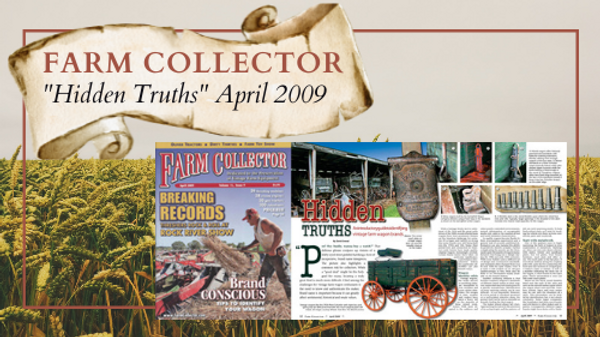Farm Collector- April 2009- "Hidden Truths"
Posted by NEWS AND PRESS on Jul 26th 2022
AN INTRODUCTORY GUIDE TO IDENTIFYING VINTAGE FARM WAGON BRANDS
"Psst! Hey buddy, wanna buy a watch?" That dubious phrase conjures up visions of a shifty-eyed street peddler hawking a host of inexpensive, brand name timepieces. The picture also highlights a common risk for collectors. While a "good deal" might be the holy grail for many, locating a truly great find is much more difficult. Chief among the challenges for vintage farm wagon enthusiasts is the need to know and authenticate the maker. Brand name is important because it greatly affect sentimental, historical and resale values.
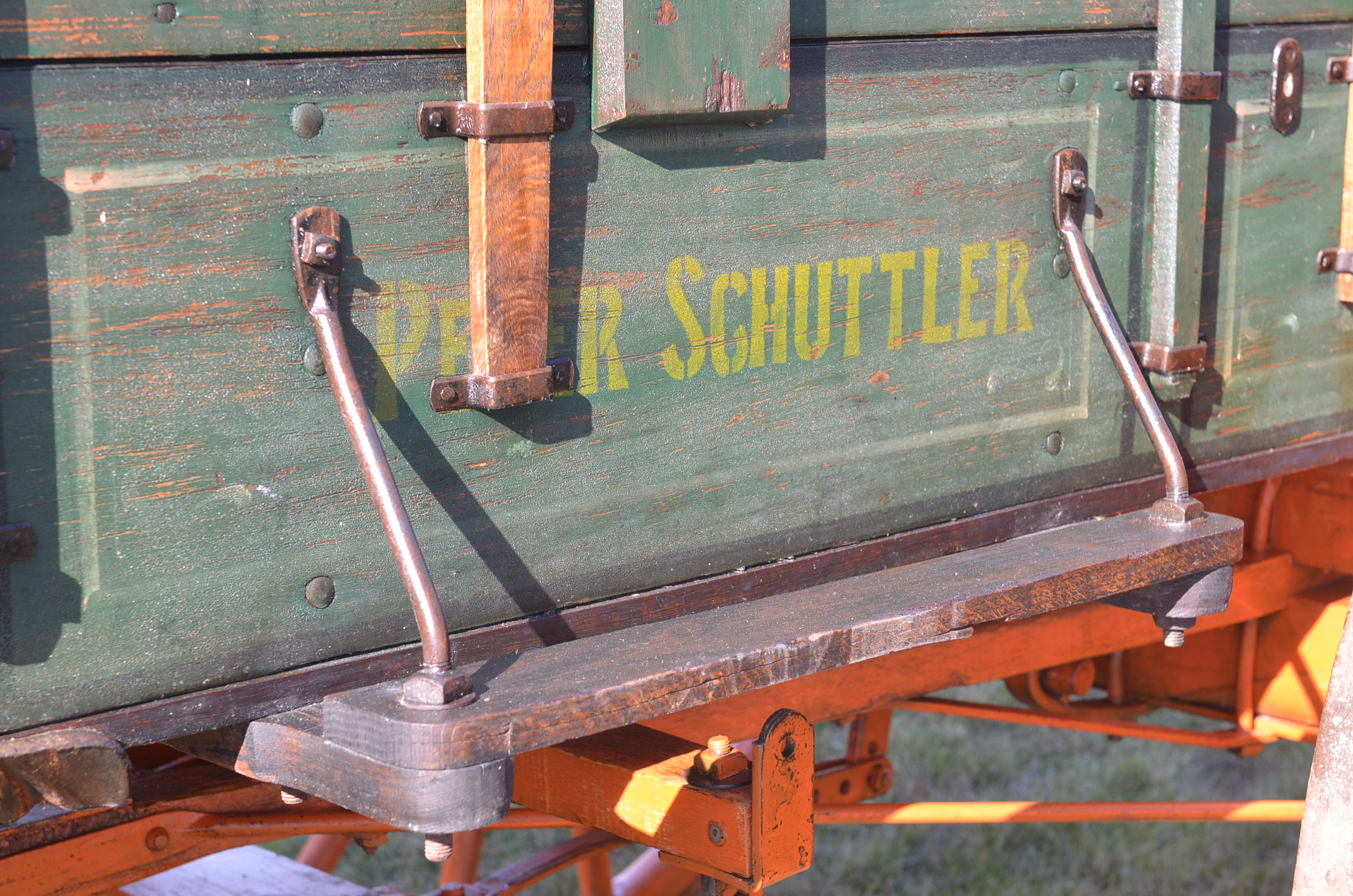
With a heritage firmly tied to settlement of the West and the great cattle drives of the 1800s, wood-wheeled farm wagons have been prominent fixtures on the American landscape for centuries. It’s a legacy and viability so strong that some brands were still being built into the 1950s and ’60s. Today, their period look and connection to America’s early history have made quality, original wagons increasingly coveted. Certain brand names have taken on particular significance; a provenance (documented history for a particular collectible) can also benefit values.
Wagon identity crisis: A vintage wagon, like nearly anyone or anything today, is susceptible to lost, mistaken and even stolen identities. The ravages of time, weather and neglect have taken a heavy toll on the majority of these retired workhorses. With most relegated to the outdoors and other poorly controlled environments, natural deterioration of recognizable marks only adds to the number of lost and easily mistaken characteristics. As quality wagons become harder to find, unscrupulous opportunists and a general lack of accurate, published information can also hamper the ability to positively identify a maker.
Further complicating the puzzles are the thousands upon thousands of wagon manufacturers that hung out a shingle during the 19th and early 20th centuries. With every builder came a different set of design and construction standards, and standards often changed from year to year with the same maker. Even if a name is still evident on an old gear (undercarriage) or box, there may be little or no information readily available on the brand’s history. Another confusing obstacle is that builders routinely assigned a multitude of different brand names to their wagons; names that may not clearly point to a specific manufacturer. Identification of every surviving vehicle can be very difficult – if not impossible. However, if you’re partial to whodunit mysteries or a well-scripted detective show, the pursuit itself can be just as enjoyable as actually finding the ideal wagon. The maker almost always left clues. Approaching the task with the attention of an archaeologist and the patience of Job can yield surprising results. To help find residual clues, we’ll start by breaking the vehicle into three sections: metalwork, paint and woodwork.
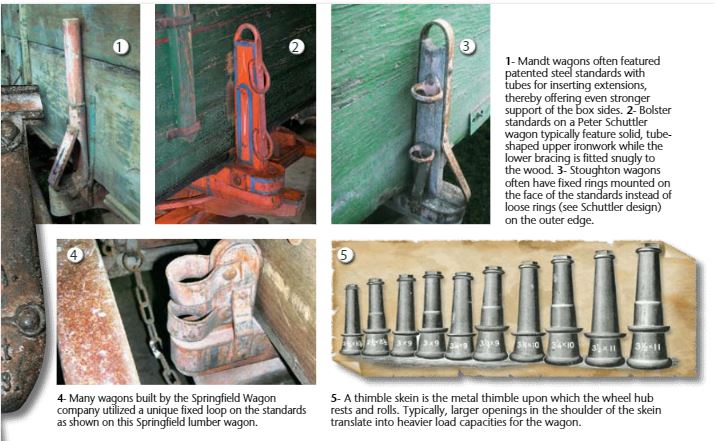
Start with metalwork: One of the quickest ways to begin narrowing the field of makers is close examination of metalwork. Markings are often cast into axle skeins (rhymes with stains), bolster and sandboard plates, box rod plates, front hound hardware, reach plate and other areas. The reach plate is the flat piece of iron about midway along the coupling pole with a pin slot for connecting the front and rear sections of a wagon gear. A maker’s name or initials, as well as a number indicating the skein size of the wagon, is often found on the reach plate. Patent information is even cast into some reach plates. Skeins are the thick, metal thimbles fitted over the ends of the axles and serve as the smooth surface upon which the wagon wheel rests and rolls. Numbers, initials, logos and even names may be cast into the shoulders of a skein. This information can be helpful for identification but is not always conclusive.
Some larger companies, like Studebaker, had their own foundry and sold skeins to other makers and repairers. Consequently, different wagon brands might have skeins with a Studebaker Brothers (SB) mark but have no other affiliation with the company. Unique designs, logos and numbers may be found on bolster/sandboard plates (fifth wheel) and box rod hardware. Prominent brands regularly touted the differences and advantages of their fifth wheels since that was a component that sustained a lot of stress and could weaken over time. Elsewhere, the style of metalwork on standards, circle irons, reach boxes and overall bracing can also contain information but usually must be compared to period catalogs for complete authentication.
Names are sometimes cast into brake ratchets, the serrated, latching section of the hand- or foot-operated wagon brake. Typically, this is not the wagon maker’s name but simply that of the maker of the brake part. Since brake manufacturers sold to many vehicle builders, this data is usually of minimal benefit. However, there are always exceptions and it’s still a good idea to document any markings found here. Even when the brand is known, it’s important to pay attention to subtle construction features. Several years ago, I watched a very nice triple box Weber wagon sell at auction. It still had a significant amount of paint and, as might be imagined, it brought spirited bidding and a healthy price. Close inspection of the iron and woodwork, though, revealed that the entire front rocking bolster did not match the rear and was not from a Weber wagon.
Details in paint The topic of paint includes all references to the overall shape, style, location and color of pinstripes, base colors, logo application, stenciled serial numbers, maker and dealer names, wheel and skein sizes, and other pigment-based marks. Many times, the wagon box and even the rear axle or bolsters will retain the name of a hardware store, implement company or other business establishment. This is typically not the wagon maker but the retailer of the vehicle. The practice of applying the dealer’s name goes back to the 1800s and is a marketing tradition still alive in today’s automobile industry. As with methodical evaluation of metalwork, all remaining original paint should be carefully documented. Even if the wagon has been repainted or the paint appears long gone, traces of valuable information can be found.
Original paint colors may still be present beneath hub bands and other metal parts. Original color information is useful because it can help shrink the pool of potential makers. If the vehicle is still in an original state, it’s important to remember that stenciled lettering and numbers can be found anywhere on the box, gear and wheels. This sometimes means the box will need to be carefully lifted from the gear to allow a visual search of the top of the bolsters. Stenciled information typically details wheel heights, skein sizes, track widths, capacity information, brand/maker name or logo, serial numbers and patent numbers. Patent numbers are especially helpful since they can be quickly researched.
No easy answers I receive numerous queries asking how a particular wagon maker painted his wagons. It’s one of the most difficult questions to answer because few, if any, makers painted their wagons a particular way on a consistent basis. Times and preferences changed just as they do today, and knowing how a brand was colored during one era doesn’t guarantee it was made the same before or after. Original paint information can be tough to come by as it usually requires knowledge of the general time frame in which the vehicle was constructed. While information does exist in a few private collections, details can also be found in museums or historical societies in the city where a given wagon was manufactured.
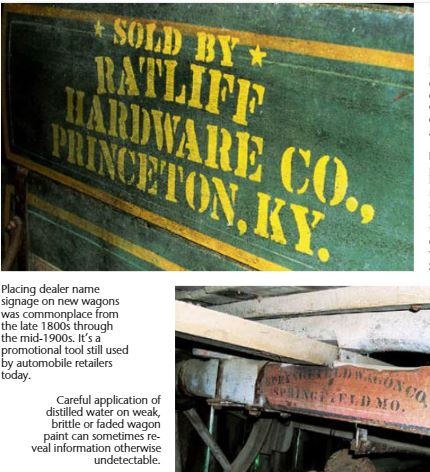
For instance, fans of 20th century International Harvester branded wagons like Weber, Columbus, Steel King and Buckeye can obtain color information by contacting the Wisconsin Historical Society in Madison. The identification process can be lengthy. As a result, it’s important to gather as much clear, detailed photography as possible. Sun, rain, heat, cold, dirt and other environmental pressures play havoc with paint, making it first on the list to deteriorate and disappear. Consequently, unless the wagon is in a light-, temperature- and humidity-controlled environment, the paint will continue to suffer ill effects. Detailed imagery helps preserve what is still visible for future study. Should the paint or stenciling be extremely faded, distilled water can be carefully applied. Sometimes water will help add enough contrast to allow numbers, letters and logos to be legible.
Because original paint on these old vehicles is usually very fragile, brushes, high pressure washes and other heavy-handed approaches to cleaning should be avoided. I also typically resist putting oil-based preservatives like linseed oil on bare wood as they can permanently discolor and even devalue a quality wagon.
Reading the woodwork When it comes to woodwork, no area should be overlooked. Some makers pressed numbers, symbols and other data into different areas and simple, cursory searches can easily miss these features. I’ve found details like those imprinted on inside box panels, side board cleats, and bottom and top of the box floor as well as inner and outer axle faces, inner wheel felloes, bolsters and brake blocks. One surviving mark may not be enough for identification, but when combined with other indicators from different parts of the wagon, it can be vitally important.
The type of woodwork along with the overall fit, finish and style of craftsmanship can also lend specific clues. Different brands often used different styles of construction. Some of these unique design traits had an engineered purpose while others were merely decorative. The Newton Wagon Co., Batavia, Ill., offers a good example. Instead of incorporating a straight hound on the front gear like most builders, a significant portion of Newton’s 20th century farm wagons were built with drop-front hounds that helped reduce wear and turning friction on the wagon. Other makers, like Peter Schuttler, Chicago, added extra contouring and elaborate pinstriping to the wood, reinforcing their quality reputation with stylistic distinction.
Careful research is key. A gentleman once asked me whether the Miller Wagon Co., Edina, Mo., ever built wagons with a steam-bent, wooden front hound. It seems he had passed up an opportunity to buy a rare, well-preserved Miller wagon because he believed the wagon hound was not original. Unfortunately for him, he was mistaken. Knowing the level of originality is not only essential to determining the maker, but can also be key to making sound investment decisions. In some cases, the potential value of a wagon may warrant hiring a qualified consultant to help authenticate and document the vehicle.
Also consider overall measurements. Wheel heights, tire widths, hub sizes, box sideboard heights and even the geometric design of the sideboard cleats should be reviewed. Specific features of accessory items such as toolboxes, endgates, brake systems and rein holder position can also point to individual maker differences. While spring seats, tongues, singletrees and doubletrees can also hold valuable maker information, these pieces are often transient. Since they are easily transferred from one wagon to another, over time they may no longer be original to the wagon being reviewed. Overall, it’s important to continue looking beyond single construction features and secure as much detailed documentation as possible. The collective whole of information will help avoid the pitfalls of misidentification while also highlighting the level of originality and, hopefully, revealing the identity of the wagon.
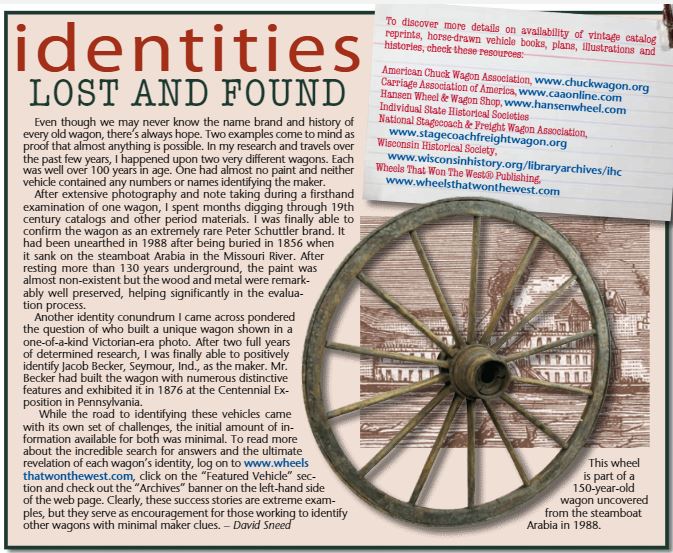
Once ordinary, now unique Wood-wheeled farm wagons were the most prevalent vehicle on the farms, plains, and ranches of 19th and early 20th century America. Even with such a dominant historical presence, they are still among the most unknown today.
Beyond the research challenges of an enormously large horse-drawn transportation industry or poorly kept records from maker to maker, the greatest obstacle in learning much about vintage wagons may be that almost from the beginning, their go-anywhere, do-it-all design made them so popular that they became ordinary; ordinary to the point of being taken for granted and, ultimately, counted as useless. The result is that too many of these historical connections to our ancestry have been overlooked and left to rot in a forgotten barn, shed or field. For every wagon desperately clinging to the last remnants of its wood, paint and identifiable markings, there are hundreds of thousands that have slipped away into a nameless, faceless obscurity.
While some are forever lost, there’s a growing recognition and appreciation for those still in existence. Ironically, the same wagons that sold for a few hundred dollars when new can now fetch several thousand dollars. Just like other classic vehicles today, factors such as quality, rarity, condition, originality and the brand name have a tremendous Impact on auction prices. Perhaps though, the real value isn’t monetary after all. As most who have seen an antique wagon on display can confirm, these rolling icons have a way of drawing attention. Maybe the old wheels remind us of a simpler time, a greater sense of community or possibly it’s a feeling of belonging; a connection to the hopes, dreams and raw will that built America. Perhaps those are the real hidden truths we can all enjoy from these relics of yesterday still loaded with spirit for tomorrow.
DIRECT LINKS FROM THE ARTICLES ABOVE
American Chuck Wagon Association
Carriage Association of America
National Stagecoach & Freight Wagon Association
Wheels That Won The West Publishing
David Sneed is an early western vehicle historian, writer, collector and founder of the Wheels That Won the West archives. Contact him by e-mail at info@wheelsthatwonthewest.com
We greatly appreciate the interest people have in learning more about their vehicles and components however the industry of horse-drawn vehicles encompasses a long span of time. Multiply that by a large number of makers and it becomes a laborious task.
We do offer consulting and appraisal services and would love to work with you if you feel your vehicle deems it necessary. You can follow the link below to find out more information on that.
